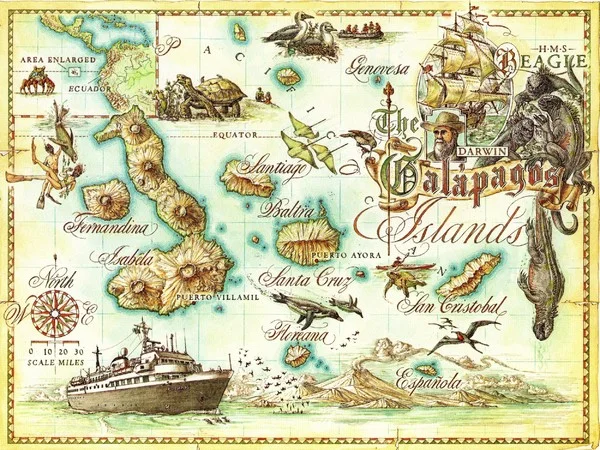Lying 970 km (600 miles) west of the Ecuadorian coast, at the Equator line, the Galapagos Islands consist of 6 main islands 12 smaller islands and over 40 small islets. The only way to reach the Galapagos is to fly from Quito or Guayaquil in mainland Ecuador. Daily flights are operated by Tame, Aerogal and LAN airlines.
Because the islands are located on the Equator, the climate is warm year round. There are two distinct weather seasons:
1) Warm & Wet season (Jan to Apr/May) with calmer seas, average air temp 23-30C, average sea temp 25C.
2) Cool and Dry season (May/Jun to Dec) with slightly rougher seas between August and October, average air temp 20-26C, average sea temp 22C.
High tourist season is considered between July and August. Tours operate out of boats or day trips out of three islands that have land based accommodations. All travel to protected islands has to be done by certified travel agencies/companies.
Posts from this trip.
Now that you know where the Galapagos Islands are and when you want to go, the big question is how are you going to experience them. The internet will be a great source to research your options. Try happygringo.com to get started. We didn't book through them, but I found their website very user friendly and informative. There are three options for you to consider:
The Galapagos Archipelago was discovered by accident in 1535, when Tomas de Berlanga, the Bishop of Panama, drifted off course while sailing from Panama to Peru. The Bishop reported his discovery to King Charles V of Spain and included in his report a description of the giant galapago (tortoise) from which the islands received their name.
Our first stop was to North Seymour Island. This is where you soon realize the incredible nature of the Galapagos Islands. The land and aquatic species have absolutely no fear of you. You are walking next to many species of birds, iguanas and even sea lions - they are indifferent to you. You can stand and watch them, only feet away. Nesting, mating - whatever they just go about their lives. That is the most incredible experience you will have on a trip to the Galapagos.
Home of the famous Pinnacle Rock, Bartolome Island consists of an extinct volcano with a variety of red, orange, black and even green volcanic formations. The island was named after lieutenant Bartholomew James Sulivan, a sailor on Darwin's ship the HMS Beagle. A trail of stairs leads to the summit of the volcano, boasting one of the best views of the islands. The beach is perfect for snorkeling and possible sightings of the Galapagos Penguin.
If you get a chance, you should try to plan your trip so it includes a visit to Santa Cruz Island where you will find the Charles Darwin Research Station. Here visitors can observe tortoise research and breeding programs. There is also a small museum that explains Charles Darwin's work and the numerous ecological programs that are in place to protect the Galapagos Islands - a World Heritage Site.
It's hard to not include over used phrases to describe ones Galapagos experience - but it does come to that. The islands are unique, stunning and a worthy addition to any travel bucket list. You walk carefully in awe - and appreciate the serenity and beauty of millions of years of unspoiled growth & evolution. The vegetation, the species, the ecosystem - now depend on us to be the guardians of their future.








